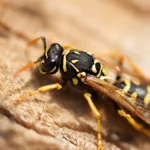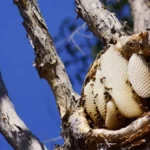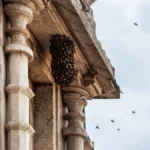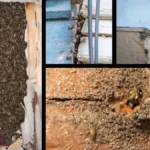In this article, we take a look at how to get rid of bee nests in the ground. Ground bees are not necessary even honeybees, so first, we have to work out “what we have”. Once we have done this we look at how to perform a ground bees removal. If that fails we explore how to kill bees underground.
How To Get Rid Of Bee Nests In The Ground
First Step – Identification Of The Type Of Insect
As a beekeeper, I am often called to remove “bees”. People will phone and say there are bees in the ground next to their swimming pool, or some such thing. More often than not, the “bees” are wasps, hornets, or even just flies emerging from a dead rabbit in its burrow.
Yellow Jackets
These will often nest in the ground. We cover this issue, and how to remove them here. Yellowjackets look a little like honeybees, and with the Dunning Kruger effect on the rise globally, a beekeeper can expect to have arguments with homeowners about the “bees” that are yellow jackets.
If the “ground bees” are not yellow jackets, let us move on to the next suspects.
Bumble Bees
Bumblebees are some of the best pollinators on Earth. In many cases, if you can educate a person about them, they may just decide to keep the nest.
If you cannot persuade the person to keep the bumblebees, we list a number of crafty ways of dealing with the problem here.
Wasps
Wasps that nest in the ground are often solitary. I have had people come to me and explain that their kid was stung by a bee “over there in the bushes”. When I went there, I could not find anything.
After about half an hour of scratching around, I saw a big black wasp that looked like this dragging a spider along the ground. They burry the spider, after paralyzing it, lay their eggs in it, and the larvae eat the living spide and emerge. It is pretty cruel and creepy. However, many people, if they have to choose between a wasp or a spider will choose a wasp.
I explained to the trusty soccer mom that these wasps are a very important part of the ecosystem and that her son getting a sting was probably because he teased the wasp. The son later admitted that he had shot the wasp with an elastic band. The wasp was allowed to stay.
If you cannot persuade the resident to keep the wasps, contact a pest removal company, or an entomologist. They will remove the wasp. University entomology departments always have students willing to do this sort of thing for some cash.
Honeybees
If the insects are honeybees, we will progress to an entire subsection on how to deal with these.

Learn more about: How To Lure Bees Into A Hive
How To Perform A Ground Bees Removal
Honeybees will quite frequently nest in the ground. This trait is more common among African bees and Africanized bees. When bees search for a place to build a nest, they search for a cavity. In many cases, they will find a cavity in an embankment, or near a pool, or under a slab of concrete where they can build their nest.
I have found that generally when bees build a ground beehive, it is not an easy job to dig the hive up and remove them. The places they choose tend to be rocky and inaccessible.
In this case, there are a number of very simple ways to get the bees out. My favorite is a “screen cone” removal.
Screen Cone Removal
Take a large sheet of thick plastic. Cut a small hole about five inches round in the middle of the sheet and insert a cone of mosquito mesh wire. The cone must have an open tip and extrude at least a foot in the air. Use duct tape to glue the cone to the plastic.
Perform this method just after sunset. Load a weak beehive in a brood box-sized hive and take it to the site. Place the sheet of plastic with the screen cone over the ground so that the cone is right over the entrance of the hive. Smoke the bees a bit before doing this to calm them.
Place soil evenly around the plastic to attach it to the ground.
The only way the bees can now get out is to climb up the screen cone and fly off to the flowers.
Place the beehive you brought with you close to the cone – maybe two inches away from it. Bees returning, laden with pollen and nectar will hit the cone, bounce into the new hive, and get transferred. This way you move the workforce over to the new hive box.
After a month or so most of the bees will have been transferred. Remove the cone, and the bees in the box will rob the honey out of the ground hive.
Fumigating Bees
Killing any kind of bees is a tragedy and should be avoided at all costs. However, there are times when we need to know how to kill bees underground. If the bees are in a school playground, or a parking lot, or some similar place where a screen cone removal will cause additional danger, it will be necessary to kill the ground bees.
There are many people who decide to try and do this themselves, and this often goes wrong. Killing bees with over-the-counter pesticides is illegal and can cause many problems. Home pesticides will leave residues on honey, and after the bees die, other animals will come and eat the honey and die. Then dogs and cats eat these animals and die.
I always advise that if bees need to be fumigated that you contact a licensed, qualified pest fumigator, who will use the legal fumigant in your area or State to solve the problem.
We hope that this article has helped you understand how to remove ground bees. If it helped and you know of anybody else with the same problem, please share.
Read more about: Can Bees Bite Humans?

Dr. Garth A. Cambray is a Canadian/South African entrepreneur and beekeeper with 28 years of experience in apiculture and specializes in adding value to honey. His Ph.D. research developed a new advanced continuous fermentation method for making mead that has resulted in a number of companies globally being able to access markets for mead. His company, Makana Meadery, exports honey mead to the USA where it is available to discerning connoisseurs. He has also developed technologies to commercially manufacture organic honey vinegar in Zambia for export globally. He holds a few patents globally in the ethanol industry and believes in technology and knowledge transfer for human development and environmental sustainability. One of his proudest achievements is the fact that the wind farm he started at one of his old apiary sites has essentially made his hometown carbon neutral.






